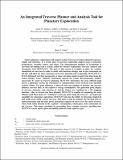An Integrated Traverse Planner and Analysis Tool for Planetary Exploration
Author(s)
Johnson, Aaron William; Hoffman, Jeffrey A.; Newman, Dava; Mazarico, Erwan Matias; Zuber, Maria
DownloadNewman_An integrated traverse.pdf (1.613Mb)
OPEN_ACCESS_POLICY
Open Access Policy
Creative Commons Attribution-Noncommercial-Share Alike
Terms of use
Metadata
Show full item recordAbstract
Future planetary explorations will require surface traverses of unprecedented frequency, length, and duration. As a result, there is need for exploration support tools to maximize productivity, scientific return, and safety. The Massachusetts Institute of Technology is currently developing such a system, called the Surface Exploration Traverse Analysis and Navigation Tool (SEXTANT). The goal of this system is twofold: to allow for realistic simulations of traverses in order to assist with hardware design, and to give astronauts an aid that will allow for more autonomy in traverse planning and re-planning. SEXTANT is a MATLAB-based tool that incorporates a lunar elevation model created from data from the Lunar Orbiter Laser Altimeter instrument aboard the Lunar Reconnaissance Orbiter spacecraft. To assist in traverse planning, SEXTANT determines the most efficient path across a planetary surface for astronauts or transportation rovers between user-specified Activity Points. The path efficiency is derived from any number of metrics: the traverse distance, traverse time, or the explorer’s energy consumption. The generated path, display of traverse obstacles, and selection of Activity Points are visualized in a 3D mapping
interface. After a traverse has been planned, SEXTANT is capable of computing the most efficient path back home, or “walkback”, from any point along the traverse – an important capability for emergency operations. SEXTANT also has the ability to determine shadowed and sunlit areas along a lunar traverse. This data is used to compute the thermal load on suited astronauts and the solar power generation capacity of rovers over the entire traverse. These both relate directly to the explorer’s consumables, which place strict constraints on the traverse. This paper concludes by presenting three example traverses, detailing how SEXTANT can be used to plan and modify paths for both explorer types.
Date issued
2010-09Department
Massachusetts Institute of Technology. Department of Aeronautics and Astronautics; Massachusetts Institute of Technology. Department of Earth, Atmospheric, and Planetary SciencesJournal
Proceedings of the AIAA SPACE 2010 Conference & Exposition
Publisher
American Institute of Aeronautics and Astronautics
Citation
Johnson, Aaron, Jeffrey Hoffman, Dava Newman, Erwan Mazarico, and Maria Zuber. 2010. An Integrated Traverse Planner and Analysis Tool for Planetary Exploration. In AIAA SPACE 2010 Conference & Exposition, 30 August - 2 September 2010, Anaheim, California. 1-28 p. American Institute of Aeronautics and Astronautics.
Version: Author's final manuscript
Other identifiers
AIAA 2010-8829
ISBN
978-1-60086-966-2